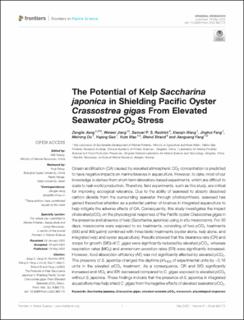| dc.description.abstract | Ocean acidification (OA) caused by elevated atmospheric CO2 concentration is predicted to have negative impacts on marine bivalves in aquaculture. However, to date, most of our knowledge is derived from short-term laboratory-based experiments, which are difficult to scale to real-world production. Therefore, field experiments, such as this study, are critical for improving ecological relevance. Due to the ability of seaweed to absorb dissolved carbon dioxide from the surrounding seawater through photosynthesis, seaweed has gained theoretical attention as a potential partner of bivalves in integrated aquaculture to help mitigate the adverse effects of OA. Consequently, this study investigates the impact of elevated pCO2 on the physiological responses of the Pacific oyster Crassostrea gigas in the presence and absence of kelp (Saccharina japonica) using in situ mesocosms. For 30 days, mesocosms were exposed to six treatments, consisting of two pCO2 treatments (500 and 900 μatm) combined with three biotic treatments (oyster alone, kelp alone, and integrated kelp and oyster aquaculture). Results showed that the clearance rate (CR) and scope for growth (SfG) of C. gigas were significantly reduced by elevated pCO2, whereas respiration rates (MO2) and ammonium excretion rates (ER) were significantly increased. However, food absorption efficiency (AE) was not significantly affected by elevated pCO2. The presence of S. japonica changed the daytime pHNBS of experimental units by ~0.16 units in the elevated pCO2 treatment. As a consequence, CR and SfG significantly increased and MO2 and ER decreased compared to C. gigas exposed to elevated pCO2 without S. japonica. These findings indicate that the presence of S. japonica in integrated aquaculture may help shield C. gigas from the negative effects of elevated seawater pCO2. | en_US |
